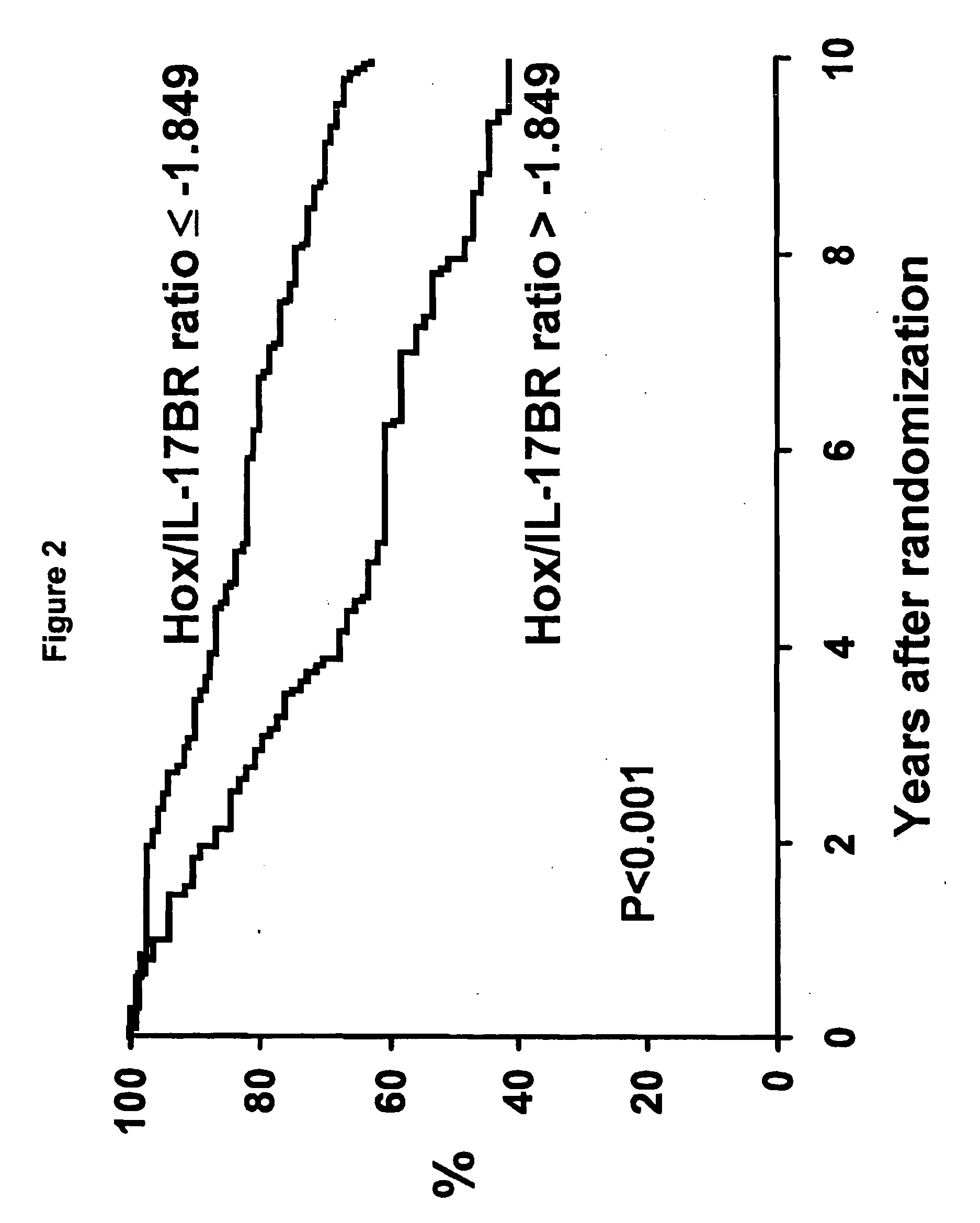Assessing outcomes for breast cancer patients
- Summary
- Abstract
- Description
- Claims
- Application Information
AI Technical Summary
Benefits of technology
Problems solved by technology
Method used
Image
Examples
example 1
Assessing Breast Cancer Outcomes Using HOXB13:IL-17BR Expression Ratios
Materials and Methods
[0050]Patients. The North Central Cancer Treatment Group conducted a randomized phase III clinical trial in postmenopausal women with resected ER positive breast cancer to assess the value of adding one year of fluoxymesterone to 5 years of tamoxifen adjuvant therapy (NCCTG 89-30-52; Ingle et al., Proc. Am. Soc. Clin. Oncol., 19:86a (2000)). Postmenopausal women with node-negative disease were required to have stage T1c or T2N0M0 cancer and could be any age, whereas women with node-positive disease were required to be at least 65 years of age with a tumor stage T1 (any N) or T2N1M0. A woman was classified as postmenopausal if one of the following held: (1) her last menstrual cycle was >12 months prior to diagnosis, (2) her last menstrual cycle was 4-12 months prior to diagnosis and her follicle-stimulating hormone (FSH) level was in the postmenopausal range, (3) she had a bilateral oophorecto...
example 2
Assessing Breast Cancer Outcomes Using CYP2D6 Genotype
Methods and Materials
[0074]Patients. The North Central Cancer Treatment Group (NCCTG) conducted a randomized phase III clinical trial in postmenopausal women with resected ER positive breast cancer to assess the value of adding one year of fluoxymesterone to 5 years of tamoxifen adjuvant therapy (NCCTG 89-30-52; Ingle et al., Proc. Am. Soc. Clin. Oncol., 19:86a (2000)). No women received adjuvant chemotherapy. The details of the clinical trial including the eligibility requirements were as described in Example 1.
[0075]Contraindications for entry onto protocol included pectoral fascia invasion, bilateral or previous breast cancer, cancer other than breast cancer with the exception of resected non-melanoma skin cancer or adequately treated carcinoma in-situ of the uterine cervix unless disease-free for at least 5 years, white blood cell count less than 3000 / μL, platelet count less than 100,000 / μL, total bilirubin or SGOT over 1.5 t...
example 3
Assessing Breast Cancer Outcomes Based on CYP2D6 Genotype and the Use of CYP2D6 Inhibitors
[0097]Patients: The North Central Cancer Treatment Group (NCCTG) conducted a randomized phase III clinical trial in postmenopausal women with resected ER positive breast cancer to assess the value of adding the androgen fluoxymesterone, for one year, to the standard five years of tamoxifen adjuvant therapy (NCCTG 89-30-52). For this trial, ER-positive was defined as ≧10 fmol ER polypeptide / mg cytosol protein in resected breast tissue by a standard biochemical assay or positive results for ER polypeptide expression in resected breast tissue by an immunohistochemical assay. The details of the clinical trial, including the eligibility requirements, are provided elsewhere (Ingle et al., North Central Cancer Treatment Group Trial 89-30-52, Breast Cancer Res. Treat. 2006)).
[0098]Using the 256 eligible patients randomized to the tamoxifen-only arm, the associations of CYP3A5 (*3) and CYP2D6 genetic va...
PUM
| Property | Measurement | Unit |
|---|---|---|
| Fraction | aaaaa | aaaaa |
| Fraction | aaaaa | aaaaa |
| Fraction | aaaaa | aaaaa |
Abstract
Description
Claims
Application Information
 Login to View More
Login to View More - R&D
- Intellectual Property
- Life Sciences
- Materials
- Tech Scout
- Unparalleled Data Quality
- Higher Quality Content
- 60% Fewer Hallucinations
Browse by: Latest US Patents, China's latest patents, Technical Efficacy Thesaurus, Application Domain, Technology Topic, Popular Technical Reports.
© 2025 PatSnap. All rights reserved.Legal|Privacy policy|Modern Slavery Act Transparency Statement|Sitemap|About US| Contact US: help@patsnap.com



